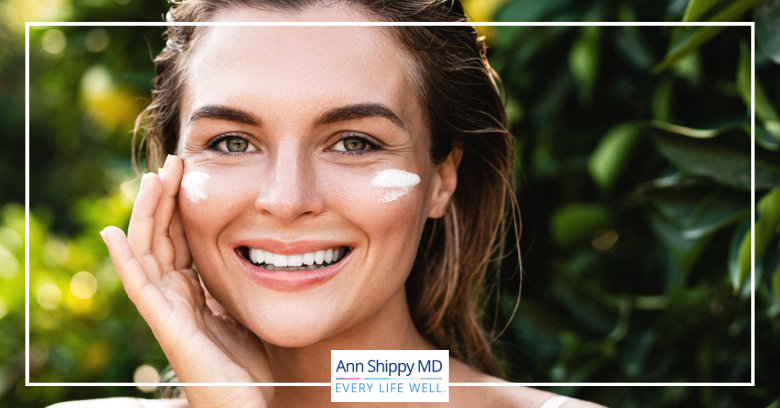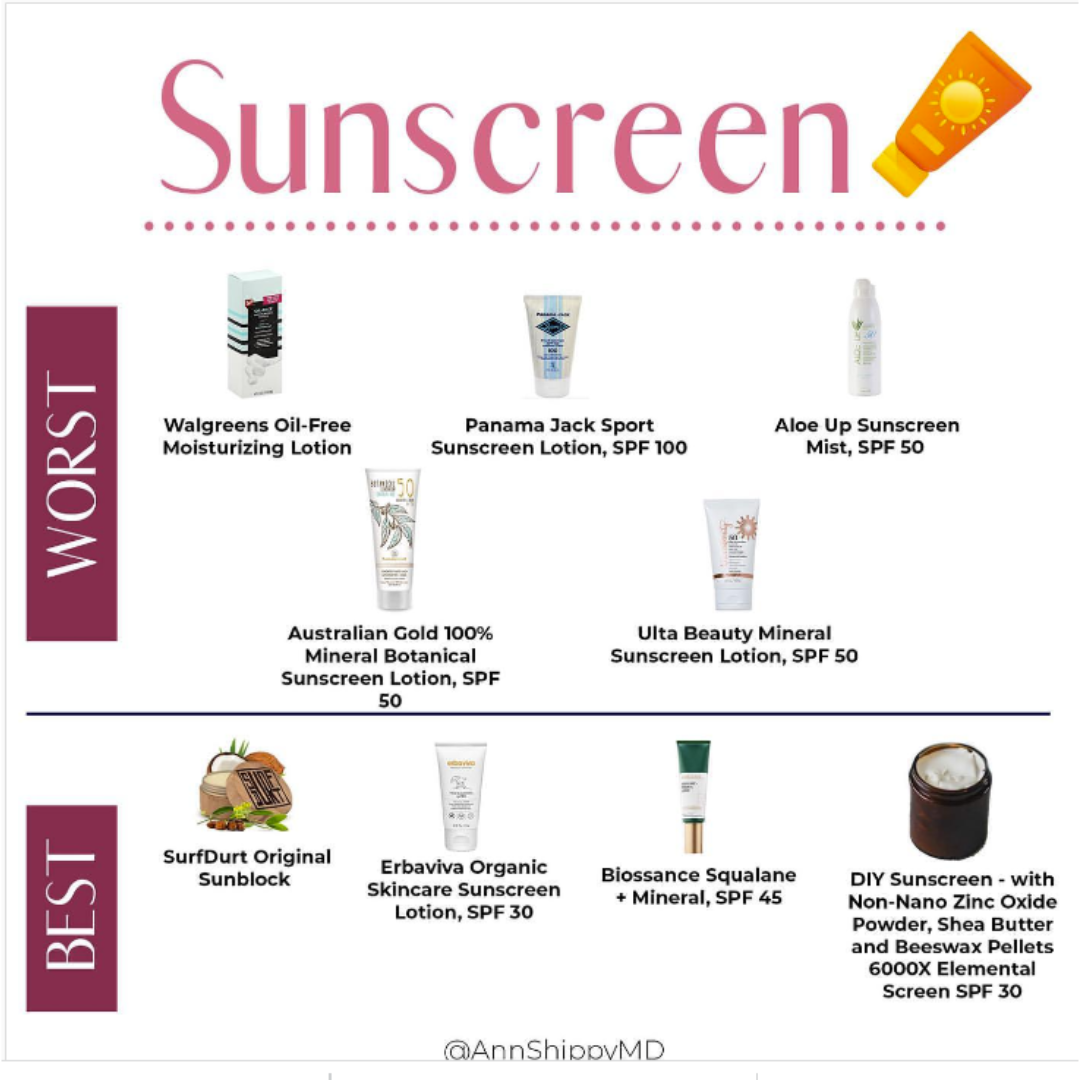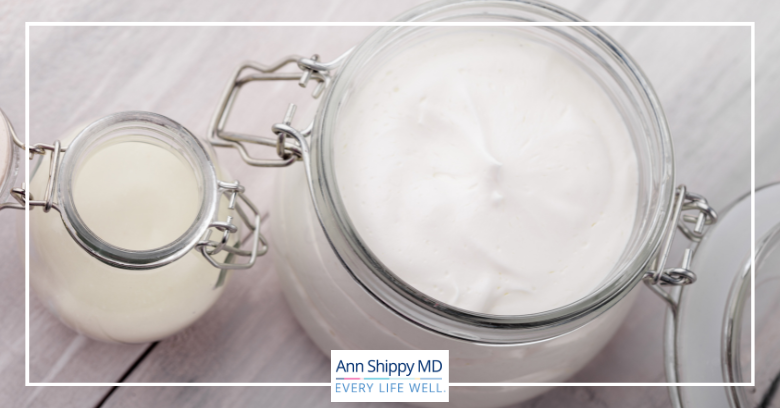Toxins In Sunscreen – Guide To Safe Sunscreen
If you are reading this, you likely care about what you put into your body in terms of nutritious food. Because the skin is absorbent, what you put on your body is equally as important.
In a recent article, we talked about toxic PFAS found in cosmetics and in this blog we are going to address toxins in sunscreens.
Sunscreen either acts as a tool for health protection, or it may contribute to health risk by exposing you to toxins and harmful ingredients.
The truth is that most sunscreens contain endocrine disruptors and other toxins that you may be slathering on our skin, and your kids’ skin, without realizing it.
The goal is for sunscreen to be protective, but also non-toxic and safe. And this is entirely possible.
Hopefully, this article will raise your awareness of the dangers of some sunscreens and help you choose safe sunscreen for you and your family.
Topics covered in this blog:
- The argument for using sunscreen
- Health risks related to chemical sunscreen ingredients
- Environmental concerns
- Tips for choosing safe sunscreen and safe sun exposure
Why Sunscreen?
Sunscreen was developed to filter UV radiation, thus preventing sunburn and damage to skin cells. Both UVA and UVB radiation are associated with DNA damage and certain types of skin cancer.
UVA radiation is more associated with skin aging (photoaging), whereas UVB exposure is more associated with sunburn.
UVB radiation is the type of radiation required for the synthesis of vitamin D.
While the public is more informed about the risks of excess sun exposure and the use of sunscreens has increased, skin cancer rates continue to rise. This suggests there is more to the sunscreen story.
Health Risks Associated With Sunscreen Use – Sunscreen Ingredients To Avoid
The health risks we face from sunscreen use is largely due to the toxic chemicals used in sunscreen, both the ingredients used to filter UV radiation as well as other ingredients that are also often found in lotions, antiperspirants and cosmetics.
Let’s go through some of the most common ingredients of concern in sunscreen. While oxybenzone has the most data, in general, safety data is lacking for chemicals used in sunscreens.
These chemicals are absorbed into the body after one use, and detected in the skin and blood weeks after the last application.
They make their way into human breast milk and they often mimic and disrupt human hormones.
Children may see increased risk because of their small body side and developmental state.
Here is a list of some of the ingredients to avoid in sunscreen and other skincare products:
- Oxybenzone (benzophenone-3) is used as a UV filter commonly in a wide array of sunscreen products. Oxybenzone is highly absorbable, may trigger skin allergies and is an endocrine disruptor. It acts like estrogen in the body and has been linked to lower testosterone in boys, reduced sperm count and high male and low female birth weight. Oxybenzone is also a possible carcinogen and has been linked to Hirschsprung’s disease. Ninety seven percent of people test positive for oxybenzone in their urine.
- Octinoxate (Octyl methyocycinnamate) is allergenic and endocrine disrupting. Oxinoxate may affect reproduction and thyroid health.
- Homosalate is another endocrine disrupting chemical found in sunscreen. The Scientific Committee on Human Safety, part of the European Commission, has determined that homosalate is not safe in cosmetics products in concentrations between 0.5 and 10 percent.
- Octocrylene may not have endocrine disrupting properties to the extent of these other chemicals, but may cause allergic skin reactions.
- Avobenzone is a likely endocrine disruption and may cause allergic reactions.
In addition to the UV filters listed above, sunscreens may contain other harmful chemicals including:
- Fragrance is a catch all term and may contain a host of chemicals and additives that aren’t required to be listed on the label. Fragrance commonly contains toxic phthalates that are known to disrupt hormones and is associated with infertility, obesity, asthma, allergies and breast cancer.
- Parabens can act as estrogens in the body and are implicated in breast cancer.
- Retinoic acid and retinyl palmitate are forms of vitamin A absorbed into the skin that, according to animal studies, high concentrations (from consistent sunscreen use, for example) may increase cancer risk.
- Benzene – Benzene is a carcinogen found as a contaminant recently in five recalled Johnson & Johnson sunscreens under the brand names Neutrogena and Aveeno. Read more about the recall here.
While the concern with chemical sunscreens centers largely around skin absorption, sunscreen chemicals can also be ingested, as is the case for UV protective lip balms, or inhaled from aerosol application. Risk of inhalation is a concern for all the chemicals listed above.
Environmental Concerns And Sunscreen
Human health risk is not the only downside of chemical sunscreen, the environment pays a heavy price as well.
One review looked at the data on four common UV filters used in sunscreens: oxybenzone, ethylhexyl salicylate, oxtocrylene and octinoxate.
The study reports that these chemicals are detectable in almost all water sources around the world and not easily removed by wastewater treatment plants. They’ve also been identified in various species of fish.
Oxybenzone, in particular, is a contributor to coral reef bleaching. Hawaii has banned oxybenzone and octinoxate in order to help protect the health of coral reefs.
Safe Sunscreen Use
As you can see, there are a lot of reasons why we should care about what we put on our skin. Even when our intentions are for health, we may inadvertently be causing harm.
As we become more informed, we are empowered to make better choices for our health, that of our children and our communities.
Eight tips and alternatives to enjoy the summer outdoors safely:
1. Choose sunscreens that contain zinc oxide or titanium dioxide. In 2019, the FDA said that these are the only two UV filter ingredients that can be classified as safe. Non-nano versions of zinc oxide and titanium dioxide are preferred.
Diligently read labels and avoid products containing the chemicals listed above.
2. Avoid sprays and powdered sunscreens due to inhalation risk. This is true for chemical sunscreens as well as mineral sunscreens containing zinc oxide or titanium dioxide.
3. Use EWG’s Sunscreen Guide. This database contains evaluations of over 1800 sunscreen products and is updated every year. Over 75 percent of the products in the 2021 database didn’t provide adequate sun protection or contained harmful chemicals. Choose products ranked “1” as the safest.
Check out this Instagram post to see some of the best and worst sunscreen options.
4. Use sunscreen wisely. Choose UV protection between 30 and 50. There is concern that higher SPF products will provide a false sense of protection. In addition, it is recommended to apply sunscreen 15 minutes prior to exposure and reapply every two hours, or more often when sweating or in water.
5. Cover up. You can also avoid excess sun exposure by seeking shade or wearing a large brimmed hat and sun protective clothing.
6. Some sun exposure is actually good. We evolved as outdoor creatures and some sun exposure is important for vitamin D production. Fifteen to 30 minutes daily without sunscreen may be beneficial depending on where you live, skin tone and individual sun tolerance.
7. Increase antioxidants. Many antioxidants are found in skin care products or in sunscreens themselves. These help to protect cells from free radical damage generated by exposure to UV rays.
Ingredients to look for include: vitamin C, vitamin E, silymarin, green tea, rose hips, red raspberry oil and others.
Increasing internal antioxidants through a nutrient-dense Paleo diet and supplements is also beneficial for skin health and protection.
8. Filter your water. This simple strategy helps to protect you from many different toxins found in drinking water, including sunscreen chemicals. If you have the option for a home filtration system, that is the idea. AquaTru is a great countertop option.
If you are using a product on your skin every day for life, then it should be tested for long-term safety and actually benefit your health instead of adding to the toxic burden that your body carries.
Unfortunately, most chemicals are brought to market without adequate safety data and only later do we realize the risks that we’ve all been exposed to unknowingly. This is often heartbreaking and infuriating to those of us who are working so hard to care for our health.
When it comes to sunscreen, there are safe alternatives to toxic or questionable products. These are widely available and offer the same level of protection.
With a little bit of research before making a purchase, you’ll be able to enjoy the sun and all of your summer activities safely, with peace of mind.
DIY Sunscreen
Ingredients:
- 1/2 cup of almond or avocado oil
- 1/3 cup of cocoa butter
- 1/4 cup of beeswax pellets
- 1/4 cup of coconut oil
- 1/4 cup of non-nano zinc oxide
- Essential oils – 10-15 drops – optional
Instructions:
Melt the avocado oil, cocoa butter, beeswax, and coconut oil and cool slightly. Add the non-nano zinc oxide and any essential oils. Whisk all together and store into a glass jar.
References
- https://www.ewg.org/sunscreen/report/executive-summary/
- https://www.ncbi.nlm.nih.gov/books/NBK537164/
- https://pubmed.ncbi.nlm.nih.gov/28844799/
- https://pubmed.ncbi.nlm.nih.gov/29086472/
- https://www.ewg.org/sunscreen/report/the-trouble-with-sunscreen-chemicals/
- https://ec.europa.eu/health/sites/default/files/scientific_committees/consumer_safety/docs/sccs_o_244.pdf
- https://ec.europa.eu/health/sites/default/files/scientific_committees/consumer_safety/docs/sccs_o_249.pdf
- https://pubmed.ncbi.nlm.nih.gov/22612478/
- https://pubmed.ncbi.nlm.nih.gov/21155623/
- https://ntp.niehs.nih.gov/ntp/htdocs/lt_rpts/tr568_508.pdf
- https://www.fda.gov/safety/recalls-market-withdrawals-safety-alerts/johnson-johnson-consumer-inc-issues-voluntary-recall-specific-neutrogenar-and-aveenor-aerosol
- https://pubmed.ncbi.nlm.nih.gov/29981751/
- https://pubmed.ncbi.nlm.nih.gov/30484882/
- https://pubmed.ncbi.nlm.nih.gov/30444533/















